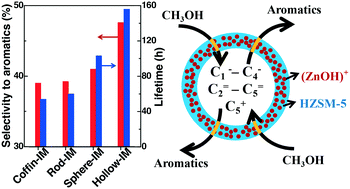Highly active and stable Zn/ZSM-5 zeolite catalyst for the conversion of methanol to aromatics: effect of support morphology†
Abstract
In this study, zinc species were introduced into HZSM-5 zeolite supports with coffin, rod, sphere and hollow capsule morphologies by wet impregnation. The regulation of the morphology of HZSM-5 zeolite supports on modification effect of zinc, as well as subsequent catalytic activities for the methanol-to-aromatics (MTA) process were investigated by multi-technologies. The results indicated that the catalytic activities of Zn/HZSM-5 zeolite catalysts were remarkably affected by the morphology of the supports. Among the different morphologies of Zn/HZSM-5 zeolite catalysts, Hollow-IM possessed superior selectivity for aromatics (48.59%), and their catalytic activities followed the order of Hollow-IM > Sphere-IM > Rod-IM > Coffin-IM. The superior catalytic performance of Hollow-IM was attributed to the hollow capsule structure and mesoporous shell, which not only achieved a good synergistic effect between active (ZnOH)+ and acid sites by facilitating the formation of the highest content and uniform dispersion of (ZnOH)+ sites, but also increased the contact time as the primary products escaped from the hollow cavity through the Zn/HZSM-5 shell. Furthermore, this special structure promoted the faster removal of precursors of carbon deposition, as well as facilitating the diffusion and mass transfer of the reactants and products, thereby endowing Hollow-IM with enhanced catalytic stability (156 h).



 Please wait while we load your content...
Please wait while we load your content...